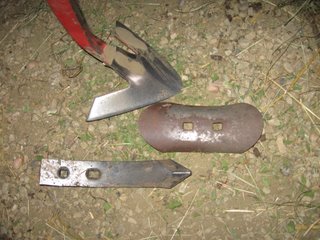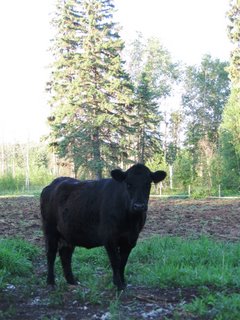
We finally got the rain we were looking for! It has rained off and on for the past few days. Sunday for instance, it rained almost the entire afternoon. We sure needed it. The lawn is starting to green up again now that it has had a drink. We had a family reunion to attend this past weekend so I didn't get much of a chance to get any farming accomplished. I came home early though and was home all day Sunday while the family stayed at the reunion. Of course, I wasn't planning on having it rain for most of the day...but I still managed to get the summer fallow worked in the morning. The potatoes are looking great! I checked them carefully for bugs and disease and aside from a little drought stress, everything looks fine. I even have some True Potato Seed pods forming on some of the plants! Most people don't realize that you can propogate potatoes in two ways...one is to plant the tubers as seed potatoes, the other way is to process the seed pods and plant the small potato seeds (they resemble tomato seeds). More about that in another upcoming post.
I wanted to talk today about cultivation and in particular, cultivator shovels and their uses. In the picture are three different shovels or 'sweeps' that I use on a regular basis. Actually with the exception of some minor differences, these are the three types of sweeps that exist to the best of my knowledge. The top sweep goes by any number of names...I know them best as "crows feet" sweeps or "cotton" sweeps. They are designed primarily for the tillage of summer fallow where weed control is desired without a tremendous disturbance of soil. The 'wings' glide under the earth and sever the tap roots of some weeds while throwing other, shallow rooted, weeds onto the surface to dry out and die. I use these sweeps for my summer fallow and other soil that is almost ready for seeding. They are not meant to be used deeply, just under the surface in order to conserve moisture. They work best with loose soil that has few clumps.
The middle sweep is called a "beaver tail". These points are used to disturb the soil in an aggressive manor, but they cannot easily penetrate hard packed or sod types of soil. A perfect use for these sweeps would be when I need to cultivate a green manure crop or stubble. These sweeps work the soil less than a plow but deeper than a disc. It is a deeper tillage designed to aerate and loosen the soil in fall and spring when moisture loss isn't a big concern.
The "chisel point" is an aggressive type of sweep that is quite narrow and sharply pointed as you can see. This point is successfully used in heavily compacted soil or a field that is deeply rooted in sod. I successfully used the chisel points in a field of quack grass. Over the years, this field was allowed to grow out of control. The soil was not hard packed, but was thick with sod, roots and wood debris. I initially tried using the plow, but it kept getting plugged up with all the debris. With several passes, the field gradually turned to dirt to the point where I could harrow between cultivations. This field will be ready for seeding this fall. It will be seeded in a winter cereal crop for grazing. Next spring, we will seed it in pasture.














